In the early 1980s, a series of adult films started to appear that were credited to the ‘Lewis Brothers of Detroit.’
The movies were well-made, 35mm features, and included ‘The Blonde‘ (1980), ‘On White Satin‘ (1980), ‘Ladies Night‘ (1980), ‘11‘ (1980), ‘Trashi‘ (1980)and ‘Every Which Way She Can‘ (1981). They starred many of the biggest names of the golden age, such as Seka, Annette Haven, Dorothy LeMay, Lisa DeLeeuw and Lysa Thatcher.
But as for the identity of the Lewis Brothers themselves, that remained a mystery. They appeared to be a collective consisting of Harry Lewis, Elliot Lewis and Louie Lewis, and even a ‘sister’, JoAnn Lewis.
And after seven years and fifteen films, the Lewis Brothers stopped making films and disappeared.
So who were the Lewis Brothers? Where did they come from, and where did they go?
In this Rialto Report, ‘Harry Lewis’ (whose real name is Lee Utterbach) reveals the story behind the Lewis Brothers for the first time. But his story is much more that just that. It is also the history of the golden age of the West Coast adult film industry in the 1970s and early 1980s.
Many thanks to Lee Utterbach and Richard Pacheco for this exclusive.
_______________________________________________________________________________________________
1. Early Days in Los Angeles
I was born and raised in the San Fernando Valley. I spent my childhood in a house in Tarzana with my parents. My interests growing up were surfing, skiing and spending summers in Colorado on my grandmother’s ranch.
I graduated from Montclair College Preparatory in 1965 and attended Pierce Junior College and then Northridge State College. I got married when I was 19 years old. I worked full time while going to college and eventually dropped out when I was 21 after I separated from my first wife in 1969.
I was struggling along doing two jobs, working for Deluxe Check Printers in Chatsworth, CA during the day and at another printing company in the evening. It was the height of the Vietnam War and lots of young men were being drafted. Sure enough, I got my induction papers. My father told me that if I was going to get drafted I should sign up to become a helicopter pilot, because then I could learn how to fly without even having a college degree, and be a helicopter pilot after I came home.
Around the same time, I went to my doctor because I was having dizzy spells… probably from working two eight-hour jobs at the same time. I mentioned to him that my father had recommended I become a helicopter pilot.
The doctor looked at me and said, “Are you out of your mind!? Do you know how long a helicopter pilot lasts? About 18 minutes in the air… and then they’re shot down.”
The doctor had his nurse come into the room and he left. She told me that the doctor could help me avoid the draft but he could never talk to me about it directly. She would be the go-between. The procedure was that the nurse sent me to pick up medical supplies for the doctor, so I went and picked up a case of glucose in downtown Los Angeles. She told me to take four bottles out of the case and keep them. I was told to fast for two days and then drink a bottle of glucose and come back to the doctor’s office for diabetes testing. Sure enough, because of the glucose my numbers were very high, so the doctor wrote a letter for me to take to the draft board when I had to go downtown for the induction.
Two days before my induction I fasted again, and before I went into the draft board, I drank two bottles of the glucose. While I was waiting with the letter from my doctor, I went into insulin shock. The army doctor decided to send me to an outside lab to test me for diabetes. So, a few days later, I fasted and did the glucose thing again and went to a lab in Marina Del Rey. Once again I went into insulin shock.
The army classified me 1-Y which meant I wouldn’t get called up unless there was no one else left to be drafted. It was sort of one step above 4-F – the army classification meaning that someone is completely unacceptable for service in the Armed Forces.
The doctor let me pay him for all the medical bills I’d incurred by doing odd jobs around his house, things like changing the clutch in his daughter’s Volkswagen.
After it was confirmed that I wasn’t going to go to be drafted, I celebrated by driving to San Francisco because it was the end of the Haight Ashbury and summer of love era. I stayed there for a while and then moved back in with my parents and started looking for a job. There was a newspaper called the Valley News and Green Sheet which had an advertisement that said, ‘Wanted: Friday Photo File Clerk.’ I went to this place on Fulton Avenue in North Hollywood and applied.
The Company was called Jaybird Publications. They’d published nudist magazines and were now putting out simulated sex publications.
As far as I knew at the time, the bosses of American Art Enterprises were Robert Reitman and Bill Speight. Later I found out that Milt Luros and his wife Beatrice owned the entire empire. Luros had once been a talented illustrator for detective books and pulp fiction in New York. In the 1950s, when he saw that that the business was on the way out, he moved to California and got into men’s magazines.
The job that was being offered was for somebody to file the company’s photos; they had ten staff photographers who went out three times a week and returned with their pictures and proof sheets – and they needed someone to organize it all.
My job was to file all the proof sheets and photos from the shoots so that they were readily accessible to the editors when they needed photos to accompany the articles written by the magazine’s staff writers. In those days, you had to have an article to go with the simulated sex photos to be able to defend it legally. The article gave the pictures some sort of socially redeeming value.
I first got interested in still photography after I separated from my wife. My father had some darkroom equipment and I’d started going to the Sunset Strip at night and photographing the confrontations between young people and the police.
While working for Jaybird Publications, I used to travel to places at weekends to take pictures. I’d go back to the Deluxe Check Printers office building on Friday nights because it was right by the railroad tracks. Trains would go past very slowly before they would head up the line and pass the Spahn Ranch where Charles Manson lived for a time. Back in the days when I’d worked at Deluxe Check Printers I’d always fantasized about jumping a train like I had seen James Dean do in the movie ‘East of Eden’. Now, with my 35mm camera and a small back pack, I did the same and climbed on several freight trains and rode away for the weekend – to San Francisco, the desert town of Mojave, and other places – taking pictures and meeting other travelers. On one trip, I met West Coast Shorty and Johnny Kline, two famous hobos, who traveled between Oregon and Florida all the time.
Back at Jaybird Publications there were two divisions: There was American Art where I worked, which was more about hippies and nudists having vanilla sexual encounters. Then they had another division which was on the other side of the alleyway in another building. That was called Parliament News. They produced a whole bunch of different publications with girls in nylons and garter belts and things like that.
After working there for a while, one of the photographers, Stan Grossman was let go. I went to my manager, Larry Gaynor, who was the photo editor, and said, “I want to do this. Can I become a photographer here?”
He said, “We’ll let you try it. We’ll send you out with Paul Johnson and he’ll teach you how to take pictures.”
Paul was one of the staff photographers and he was very accomplished. I was lucky enough that he became my mentor and taught me everything I needed to know, not only about photography but just as importantly about the ins and outs of the business at Jaybird Publications. There was a lot of politics in the company and Paul taught me how to survive and not piss off the other staff photographers.
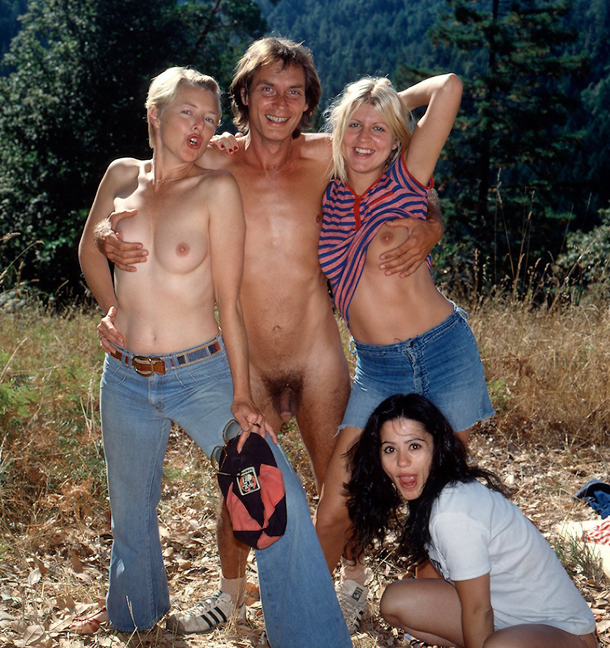 Paul Johnson, with Juliet Anderson (left) and Sharon Kane (right)
Paul Johnson, with Juliet Anderson (left) and Sharon Kane (right)
Paul also introduced me to the modeling agents and got them to set me up with experienced models that were more familiar with the process of photo shoots. They did all their own poses and I just snapped the pictures. This was helpful as I had no idea what I was doing, and I had my hands full just making sure the strobe lights were working and my exposures were correct.
Jaybird Publications was based in Los Angeles and had ten staff photographers. We each did three shoots a week. So, that meant thirty shoots in total. And every time we shot, we did five different photo sets with three people. This meant that if we had a guy and two girls, we’d shoot each of the girls by themselves, the two girls together, and the guy with each of the girls.
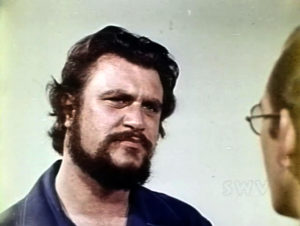 You can imagine how many models we needed… We used to go through all these agents in Hollywood constantly looking for new people to shoot. I worked a lot with an agent named Reb Sawitz (see picture), and a guy named Irv Sofsky who owned the Photo West Model Agency. We’d go to these booking agents and they’d put together the models for us. It was also the agent’s responsibility to make sure the models were of legal age and have them show up at the scheduled date and time. We didn’t know who we were going to photograph because we had to go through so many each week.
You can imagine how many models we needed… We used to go through all these agents in Hollywood constantly looking for new people to shoot. I worked a lot with an agent named Reb Sawitz (see picture), and a guy named Irv Sofsky who owned the Photo West Model Agency. We’d go to these booking agents and they’d put together the models for us. It was also the agent’s responsibility to make sure the models were of legal age and have them show up at the scheduled date and time. We didn’t know who we were going to photograph because we had to go through so many each week.
I worked with people like Rene Bond and her boyfriend, Ric Lutze. I photographed Rene often. At the time, she was one of the biggest names out there. And cute also. I had a crush on her. She was just a real nice girl. Rene and other actresses would do still shoots, even though we couldn’t pay them anywhere near what they made in the films.
At some point, American Art and Parliament News were combined and my boss Larry Gaynor was phased out. My new bosses were Fred Fixler and Will Hulsey, who had been the head of Parliament News. Fred couldn’t stand all the photographers that he inherited from the American Art side of the business and he would give us these ridiculous story lines to shoot.
One time he said he wanted pictures of a couple’s wedding night. I was going to use Rene and Ric. I knew them well by now, so I said, “Rene, bring a wedding dress. Ric, you get a tuxedo.” We got to the place to do the shoot and realized Ric didn’t have any socks. It was the Valley. It was 110 degrees. I was wearing cut off shorts. Nobody had any socks! I tried to shoot around it, but when Fred saw the pictures, he was livid. He refused to use a shot of them standing there with the guy wearing no socks. He had standards, I guess.
Once a week all the staff photographers would have to go to an obligatory staff meeting with Fred which generally lasted about two hours. This was the part of the job I hated the most. Fred would berate us about how terrible the models looked and how awful our work was.
Occasionally I worked on films. I remember working for Dave Arthur, who used the name Kirdy Stevens. One time we were out in Hollywood and Ric Lutze was there but Rene wasn’t. I was sitting there talking to Ric. He was a genuinely nice guy. He told me that he and Rene had split up, and that he’d moved back to somewhere like North Carolina or Georgia where he was from. He’d got a job as a teacher at a military academy for boys. He said he was so happy to be working with these kids. It was his dream came true. One day some administrator at the school had come across a magazine with his pictures in it. They called him in front of the academy and fired him right on the spot. It wiped him out. So, he went back to Hollywood trying to make movies again. It was a sad story about what happened to people back then.
In those days, filmmakers couldn’t go to Technicolor to develop their X-rated footage. They wouldn’t take it. So, everyone used this guy in Hollywood called Burt Steiger who had his own film lab. Burt’s place was called Pacific Film Labs. He did a lot of films for Dan Cady, Dave Arthur, and all the other guys that were shooting these films in Los Angeles. They all took their films to him.
Back then, every time you developed film you got silver from the development process. I guess you could recoup that silver. Burt had been in the business forever, and it was said that he had bars and bars of silver stashed away. Supposedly he had it all hidden somewhere. It was ironic… the filmmakers were giving him money to develop their film, and yet he was keeping all the silver from the film processing!
I wish I’d kept the magazines where my pictures were published. It’s funny because American Art put out 30 magazines a month, and every time they published anything they made sure they gave every staff photographer a copy. It had an embossed stamp across the front that said ‘Not for Sale’. Over the course of the time I worked there I must have had about 700 of these magazines. One day this guy that I worked with said, “Hey, I know this guy who owns an adult bookstore. He’ll give you $900 for all those magazines you got.”
I said, “Sold.”
*
2. Busted!
By this time, the photo shoots had gone from depicting simulated sex scenes to actually showing real sex. The Jaybird Publications company lawyer was Stanley Fleishman, who was a famous constitutional attorney involved in several noted First Amendment cases. He told the owners of Jaybird that what we were doing was defendable, so we were told to continue photographing the models having sex.
And then I got arrested with my boss Fred.
Fred didn’t own the company but he managed all the staff photographers and he was the main photo editor. He and I were charged with pandering and conspiracy to commit pandering. Two felonies.
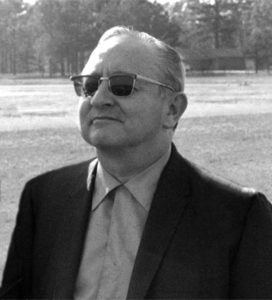 But before I was even arrested, the police had approached me separately. They said, “We’re going to take down Milt Luros (see photo) who owns American Art Enterprises.” It was the assistant district attorney, Thomas Eldon, who was behind it all; he was intent on taking Milt down. Of course, people in positions such as his are all elected officials, so he was doing it just to get re-elected.
But before I was even arrested, the police had approached me separately. They said, “We’re going to take down Milt Luros (see photo) who owns American Art Enterprises.” It was the assistant district attorney, Thomas Eldon, who was behind it all; he was intent on taking Milt down. Of course, people in positions such as his are all elected officials, so he was doing it just to get re-elected.
Two cops from Hollywood vice squad met me at a café. They told me it was just a matter of time before they made arrests. They said, “This is what is going to happen: If you want to turn state’s evidence, you can become an informant for us. If you testify for the state, we’ll grant you immunity. We won’t bother you.”
Being 22 years old, and very naïve about how the world works, I told them I was not interested.
Four months later I was photographing some people in Hollywood. Suddenly the door gets knocked down. These cops handcuff me, take me downtown, and book me. I was wearing nothing but a pair of cutoff jeans as it was the middle of summer. They took me before a judge with no shoes or shirt to be indicted. It was very embarrassing.
My poor mother was the head of the Art department at Woodbury College in Los Angeles. One day she went to work and the Dean of the college held up the L.A. Times in front of her that said, “Lee Utterbach, Pornographer: Indicted.” Front page, L.A. Times! I went to City National Bank and they’d frozen my bank account. I hadn’t been found guilty of anything but they’d frozen all my money. I couldn’t believe it.
What had happened was this: I’d been going to Irv Sofsky to get my three models three times a week. We paid him to meet the models to make sure they didn’t have any terrible scars or needle marks on their arms, to ensure that they were halfway presentable, that they had a change of clothes, and that they had something to show that they were over 18 – like a driver’s license. Irv was supposed to do all of this.
I’d photographed this one model on two different occasions. She was called Patricia Fontaine. It turned out that she was 14 years old (she looked about 37) and she was married. In fact, she’d been married illegally somewhere back on the east coast, I think it was Boston.
It was like an episode of ‘Law and Order’: The police had arrested her husband because he had a bunch of stolen car stereos in his apartment. They were telling him he was going to go to jail for five years. He said, “What if I could tell you something? Would that help me?”
So, he told them that his wife had been photographed by all these different photographers. And that it was all hardcore. The cops interviewed his wife. She signed these statements. And so, they indicted Fred and me. That’s how it all came about.
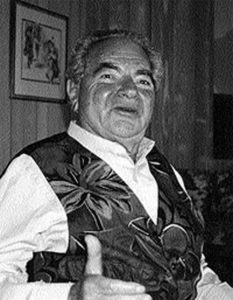 Fleishman (see photo) decided that we should opt for trial with a judge instead of going with a jury. He thought it would go better for us. Fred and I were represented by two different lawyers that worked for the Fleishman firm. David Brown was Fred’s attorney and Hugh Manes was my attorney. The trial lasted five years. For part of that time, I was completely out of that business. I went to live in the mountains as I’d always wanted to be a ski bum. I was young and dumb. I had hair down to my shoulders. I remember I went out and bought an all-white suit to wear to court. How stupid was it to wear a white suit to court when I was being charged as being a panderer? I looked just like a pimp.
Fleishman (see photo) decided that we should opt for trial with a judge instead of going with a jury. He thought it would go better for us. Fred and I were represented by two different lawyers that worked for the Fleishman firm. David Brown was Fred’s attorney and Hugh Manes was my attorney. The trial lasted five years. For part of that time, I was completely out of that business. I went to live in the mountains as I’d always wanted to be a ski bum. I was young and dumb. I had hair down to my shoulders. I remember I went out and bought an all-white suit to wear to court. How stupid was it to wear a white suit to court when I was being charged as being a panderer? I looked just like a pimp.
We went before the judge, and the judge said, “Guilty. Five years in prison.”
Then Stanley Fleishman went before the judge and said, “Your Honor, these gentlemen were my clients. I told them that what they were doing was legal and that they weren’t breaking the law.”
The judge was so impressed with Fleishman’s speech that he changed his mind and changed the sentence to five years’ probation and a $10,000 fine, which our company paid.
My probation officer told me that as part of my probation I had to start going to night classes at UCLA. I still wanted to become a filmmaker so I chose courses about film-making, directing and producing. In the classes, we’d be shown films that hadn’t yet been released to get our reaction. They’d also invite the filmmakers along to talk about the films and we could ask them questions. It was a great way to learn about film.
My conviction weighed heavily on me. After I’d done three years of probation, my probation officer was impressed that I had gone and done everything he wanted me to do. He said, “I’m going to go back to the court and see if I can have your felonies reduced to misdemeanors, and have them taken off your record.”
I said, “God! That’s great.”
He went before the court and he got the judge sign off that both of my felonies were reduced to misdemeanors and dismissed, and my probation was ended two years ahead of schedule. I have this piece of paper signed by the judge saying he did that.
*
3. San Francisco
During the time before I was arrested with Fred, American Art sent me to San Francisco to get away from Los Angeles. While I was there I met all of these San Francisco people that were making films. I met Emily Smith (aka Clair Dia), who was a model, and her husband Lee, and we all became friends. Emily and Lee had been in the X-rated film business from the very beginning.
It was a close-knit network and it was easy to make contacts in that world. Emily introduced me to Lowell Pickett who owned a theater, the Sutter Cinema. He shared a bunch of models with me. Through Lowell I met Jerry Abrams, who also introduced me to models to photograph.
Eventually through Jerry, I met this guy called Dennis, who used the name Zachary Youngblood.
Zac was trying to make his own movies and he had a company called Canard Films. He’d met a guy named Habib Carouba, who owned some gay theaters and cafés in San Francisco. Zac made films for Habib.
Zac saw me as this perfect opportunity because I’d saved up about $10,000. He showed me a spoof film that he’d made starring Annette Haven. It was based on ‘Last Tango in Paris’ (1972) and was called ‘Deep Tango’ (1974). It was OK, and it gave me confidence that he could make a movie.
Zac talked me into investing my money in a film that we would make together. He said, “If you put up the money, you’ll be the producer, and I’ll teach you how to do it. You’ll record the sound, and you’ll learn how to do this and that.” Zac was sure that he’d be able to sell the film and that I’d double my money, and then all these wonderful things would happen to our careers.
I just wanted to make the move into filmmaking and I figured this would be better than film school, so I put up all my money and we made the movie. The film we made was ‘Visions of Clair’ (1978) and it featured Annette Haven and Bonnie Holliday. We made it in 1975 but it didn’t come out for several years after.
When we finished it, we had an answer print to show around. Zac wasn’t having much success selling the film so I took it. I went back to Los Angeles and tried to get people interested in it. I started to meet a long succession of crooks that wanted me to give them the film for nothing, with the promise that they’d pay me something someday. I kept refusing. I can’t tell you how many times I flew to Las Vegas on my own dime to show it in some sleazy little theater to somebody from New York – only to be told to go away.
I spent two years of my life trying to sell it. Two years of frustration trying to get rid of the thing. Two years of thinking that this was going to be my ticket into the industry where people would start to throw money at me. After two years, I owed my father some money. I’d told him that if I didn’t sell the film I’d sell my house, so to keep my word to my dad, I sold the house and paid my dad back.
Finally, I showed the movie to a guy called Sidney Niekerk who owned Cal Vista Films. He’d made the film ‘Eruption’ (1977) with John Holmes and Leslie Bovee. With Sidney you could actually believe you were dealing with a legitimate film distributor. He was different from the other guys I’d met. Sidney finally said, “You know what, I’ll buy the film from you.” I ended up getting $10,000. I gave Zac $1,000, which was terrible because he’d done all the work, but I just wanted to get my money back. I had all my savings invested in this thing. I ended up losing a thousand bucks, but I learned a lot about the world of hard knocks.
After I sold the film, my friend Emily Smith approached me and said, “I know this guy named Dick Wolf. He’s looking for somebody to shoot loops for him.” So, I made about ten loops for Dick, and Emily was my production manager. She got all the talent together, and she’d help me get props and wardrobe. I also had to shoot a couple of roles of 2 ¼ x 2 ¼ slides for each loop. It was a strange arrangement; I never even met Dick Wolf. I just sent the film to him and that was that.
I also met John Seeman, a truly wonderful man. John told me he came to San Francisco a year earlier, wanting to be in adult films. He went to the Mitchell Brothers for an interview. They told him he was too homely-looking to ever get into films. He went on to be one of the most successful supporting actors in the industry.
John would find jobs for me and my girlfriend at the time in movies on which he was production manager. He’d say, “Hey, I got jobs for you two on this movie.” I said, “Great. What are we going to do?” He’d say, “Well, you’re a boom man and your girlfriend is the sound mixer.” I told him, “But we don’t know anything about sound!” He goes, “Yeah, but that’s the only thing that I could find for you to get you onto the crew!” I said, “Oh, all right, fine. We’re in!”
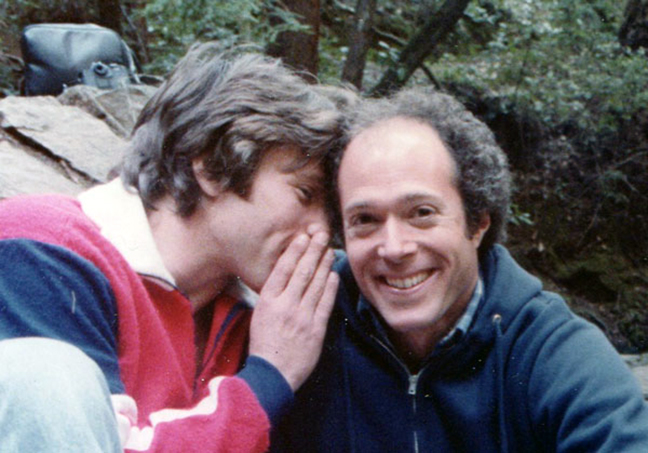 John Seeman (right), with Richard Pacheco
John Seeman (right), with Richard Pacheco
*
4. The Beagle Brothers
After I made ‘Visions of Clair’ and spent two years trying to sell it, I spent some time working at a construction company stacking lumber just trying to get two nickels to rub together so I could pay my rent. Then this guy who’d seen my film called me up. His name was Jerry, but we called him ‘The Boomer’.
He said, “I saw your movie and I’m making these 16mm movies. I need somebody to make films. Would you be interested in making some for me?”
Jerry was partners with a guy named Rudy who we called ‘Rude Rudy’. They already had a guy making movies for them in New York for them named Dick Mailer. Now they wanted someone on the West Coast to make films for them to sell.
I was excited. Finally, somebody was saying, “I’ll give you my money so you can make money for me!” All I ever wanted was for somebody to have enough faith in me to give me a budget. For the first one, Jerry gave me $6,500. I was over-budget because I wanted to make the film look as good as possible. The whole movie ended up costing $8,700, and I think I made $1,500. Then Jerry sold it for $25,000 so he tripled his money. The fact that I was over-budget didn’t hurt him. He did fine.
After that I shot many 16mm films for Jerry in Los Angeles. These included ‘Oriental Treatment’ (1977), ‘The Big Score’ (1977) and ‘Star of the Orient’ (1979).
One of the first things Jerry taught me was how to structure an adult film. When I started to make films for him, I wanted to have a story with a beginning, a middle, and an end. He immediately bitch-slapped me and said, “Here’s how it works: These are 16mm films. They’re not loops. So, it’s got to be 60 minutes long. It has to have six sex scenes. It has to have one scene with two girls. And a scene with three people. And it has to have the first sex scene within four minutes of the start of the movie.”
He said, “You have to remember that these guys come in on their lunch break and they want to watch a movie. They don’t want to sit there for half an hour waiting for the first sex scene. It has to happen right away. Got it? That’s all there is to it.” So I had to learn the whole formula, and then try to write a story around it.
Some of the films were credited as ‘A Beagle Brothers Production’ after the Beagle Boys who were a group of fictional characters from the Donald Duck universe. The Beagle Boys were always trying to break into Scrooge’s fortress and steal all his money. They were like beagle dogs, but they had little black goggles over their eyes. We even claimed some of the films were shot in ‘Beagle Vision’.
I made a lot of movies for Jerry but I used so many different names for these films that I’ll probably never be able to compile a full filmography. For example, sometimes I went by the name of ‘Young Lee’ and the producer was sometimes ‘Mr. Kezar’. These were just other names for the Beagle Brothers – in other words, me. Sometimes I’d do the credits and I’d just use the names of people that I knew… like kids I went to high school with. I think we made Thomas Eldon, the Assistant District Attorney in Los Angeles when I was on trial, the producer of ‘Oriental Treatment’.
I’m ashamed to say this but I had so little control once I turned those films over to Jerry. Many times I didn’t even know what names were used on the credits. He took care of all that. I was just the sausage grinder.
The films were shot with no budget. Maybe $10,000 at most. Jerry would take the prints and sell them. Just a print here and a print there. Once he took a print of ‘Oriental Treatment’ to New York and showed it to a guy that owned theaters there. This guy bought the film from Jerry for $25,000 and blew it up to 35mm. Now this was of interest to me because I had a deal with Jerry that if any of my 16mm films were blown up to 35mm, then I was supposed to get a $1,000 bonus. Needless to say I never received it.
So, when Jerry was out of town, I went to his partner Rudy. I said to Rudy, “Jerry promised me this money. He owes me three grand from three movies that were blown up to 35mm and I never got my bonus money. He’s never paid me and I want to buy a truck.” Rudy went into the bedroom and opened a closet door and brought down a cowboy boot. He pulled out this huge wad of $100 bills. He peeled off $3,000 for me. And I went out and bought a van.
About two weeks later I was at my apartment and there was a knock at the door, and it’s Jerry. I open the door and he was looking at me laughing. He said, “You pulled the old, ‘Boomer’s out of town’ trick on me didn’t you…?!””
I made a movie which I titled ‘What A Woman Wants’. We eventually renamed it ‘Star of the Orient’ because it featured a supporting actress called Foopie who used the name ‘Kyoto Gee’. She’d also been the star of ‘Oriental Treatment’. She wasn’t in a lead role, but she was Asian and that in itself was a big deal – so they named the whole movie after her.
I got on well with Jerry but he was often upset with me because it took me such a long time to make each movie. This was because I was doing everything myself. I was writing the scripts, casting, shooting, editing the movies creating the trailers, and cutting the negatives myself. It just took me so long, and I got bogged down.
I eventually learned a lot from reading a book about the Warner Brothers studios. The book was a collection of memos. All these memos were written between Jack Warner and the producers he had working under him. The whole book was just one memo after another. I realized that making a film is all about being organized. You may want to be a filmmaker but unless you’re organized, forget it. Your chances are one in a million. That book helped me and I changed as a filmmaker as a result.
Jerry was a real character. He’d come to my place with little tin cans. Each can had a hundred foot of 16mm film. He was so excited about it. I asked him, “What’s in the can Jerry?” He’d say, “Cum shots!” He’d get these little snippets of film from other filmmakers, and it would be just shots of penises cumming. He would put them in the trailers to make them more interesting.
Through Jerry, I met Dick Mailer who was the guy making movies for Jerry and Rudy in New York. Dick also went by the name Mr. Mustard. Dick lived right by the Flatiron building in Manhattan. He and I became good friends.
Dick was quite a character too. He was one of a kind. His biggest idol was Elvis Presley. He loved Elvis Presley. He had an Aston Martin like James Bond, a real old one, which he never used because something was always wrong with it. He was a short, thin, handsome guy. And funny, very funny. Not real athletic, but very vain. I never met anybody so vain. He was always combing his hair and looking at himself in a mirror.
Dick had his own group of friends, and they were all very tight. A lot of people liked him. He was always close to Jerry and Rudy. Rudy had an apartment that he kept near Wilshire Boulevard. Dick would stay there when he was in Los Angeles.
The trouble was that Dick was a terrible filmmaker. He wasn’t a technician at all. He’d make five movies at the same time. He’d get $50,000 from Jerry and then would go to Florida. The first thing he’d do was rent a houseboat and a jet-ski, and have these gigantic parties, and blow about 85% of the money. Then he’d scurry around at the last minute trying to make the five movies for nothing.
I worked differently from Dick. When Dick would do a sound mix, he’d have the work print and it would have the dialogue, and then there’d be music. He’d do the mix down to the one track. I spent much more time over it. I had an editing system with three flatbed machines. I bought these cables so that I could plug them into each other so I could have three pictures and six tracks of sound and dialogue. I’d have two tracks of dialogue so people could actually be talking over each other in different shots. Then I’d have effect tracks of doors closing, or cars starting. Then I’d have two tracks of effects and two tracks of music. I’d go to the mix with 12 tracks! I did it like it was a real movie. Jerry would be so impressed with me because Dick’s were so schlocky. But… the flipside was that Dick would make five movies at a time and I’d make just one.
Dick’s strength was as a storyteller. He was a great storyteller. In his films he’d have this knack of being able to add O. Henry-like twists to his plots. So even though he’d have terrible lighting, and ugly people in the movie, and he’d do it all in just a day… his films would often have a twist ending that made them interesting.
I would often base my plots on some TV show like ‘Police Woman’ with Angie Dickinson. ‘Oriental Treatment’ was based on that show for example. I mean it was so very loosely based on the TV show that you wouldn’t even know it was about Angie Dickinson! I’d try and make a parody of it. The only way I could ever make Jerry’s formula work was to have two or three plots going on at the same time so I could cut back and forth and fit in a sex scene within six minutes of the last one.
It didn’t always work. Many times I’d finish the movie and show it to Jerry, and he’d scratch his head and walk out. Then next day he’d come back with some new dialogue scribbled out on a piece of paper. He’d get me to have the actress record a voiceover just so that the audience could make more sense of the story.
Being inexperienced meant that I often learned lessons the hard way. When I made ‘Star of the Orient’, I thought I had the movie all figured out. I was going to shoot it in three days. I’d found the girl who was going to be the lead actress, and one of her conditions was I was supposed to give her $500 one week in advance so that she would show up. I thought she was kidding, so I didn’t send the money. The morning that she was supposed to show up, she was nowhere to be seen. I called her and talked to her boyfriend and he said, “Oh yeah. You didn’t send her the money so she’s not coming.”
I was literally supposed to start shooting within an hour. Everybody else was there, and I had the script completely worked out. I took everyone’s scripts away from them and completely recast the whole film in 15 minutes.
I had no choice. What could I do? I couldn’t just set it up two weeks later. It never would’ve happened. I’m sure the film suffered for it, but it made it lively for everybody to try to learn their new lines.
Even though the X-rated business was booming, it was still a small industry. I got to know other directors like Sam Weston (who went by the name of Anthony Spinelli) fairly well. I worked on several of his films in San Francisco and they had a pretty high production value. Sam was pleasant, but I felt that he was basically a frustrated guy living in his brother’s shadow. His brother was the actor Jack Weston.
The actors in the business sure loved Sam. I think that they were impressed with him because he took a lot of time and he tried to get a very good product. They liked him because he was the closest they ever got to working with a real director.
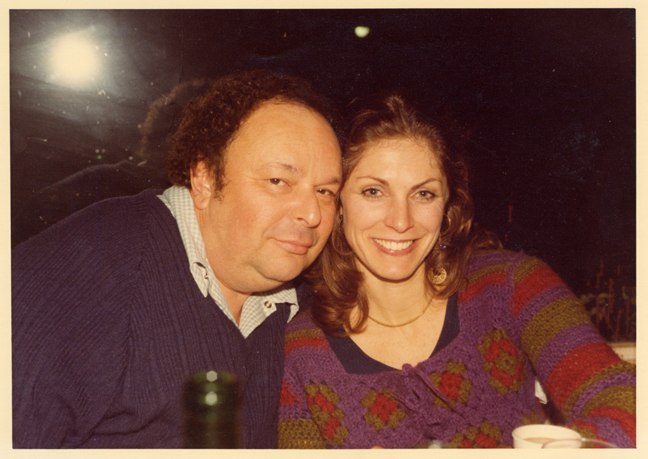 Anthony Spinelli, with Kay Parker
Anthony Spinelli, with Kay Parker
But as a crew person, I wasn’t impressed because he threw everything to the wind when it came to getting something done in a reasonable time. You could be there forever. He wasn’t thoughtful about the crew and what they were going through. So, for me as a crew person, he was a slave driver and a pain in the ass.
Once Sam and I went to the Pussycat Theater on Santa Monica Boulevard, and he took me to see a movie that he’d made. He was excited about a scene where this girl committed suicide at the end of the movie. His cameraman had taken a Bolex camera and thrown it out of the window while it was still running. I had to admit that was kind of neat. He was proud of that.
One time Sam hired me to shoot a documentary on 16mm for him. It was about his son who had some illness I think. It was an interesting experience but I never could get paid by Sam for my work on the project.
Dan Cady was another guy who shot in San Francisco because of all the legal problems in L.A. I worked on several of Dan’s films. I thought he made pretty good movies. He had this woman who would direct his films. Her name was Maria. She would direct them and he would produce. I remember her being aloof in the beginning, but once I worked on several films with them, she became much friendlier. I remember one film called ‘Little Girls Blue’ (1978) that I did with Dan and Maria about a group of Catholic school girls.
*
5. Anatomy of a Movie
In the late 1970s, Bob Chinn asked me to go to Hawaii to shoot 2nd unit for ‘Tropic of Desire’ (1979), a film about a World War II whorehouse with Georgina Spelvin. It was being paid for by Harry Mohney, who was the executive producer.
I decided to take along a 16mm camera along and a couple of rolls of film. I thought that, since my expenses were paid, I would shoot some 2nd unit for a 16mm film that I would talk Jerry the ‘Boomer’ into financing for me. I figured with some with some exteriors shot in Kauai, the project would be an easy sell.
While on the flight over, I thought up the story line and made notes on a cocktail napkin. The working title was ‘Island of Dr. Steiger’, and the inane plot revolved around a struggling couple. Rudy, the husband, works for his wife’s father who owns a supermarket. The father, Mr Sussman, (played by John Seeman) was suffering from all kinds of illnesses and he desperately wants his daughter to have a child. He gives his daughter Pam an ultimatum that she must get pregnant within 30 days or she’ll be taken out of his will. Rudy and Pam have already been trying to get pregnant but without any luck.
The couple seeks the help of a physician and he sends them to see a surgeon, Dr. Steiger, who has been banished to Hawaii (in a cameo played by me). They are told that Rudy needs to have sex with a prostitute and then save the sperm to later impregnate his wife. Unfortunately, while he is collecting his sperm, his wife, who has been watching, becomes aroused and has sex with the female prostitute. Rudy runs from the room screaming.
Pam tells her father that she is a lesbian and he has a heart attack before he can change is will. Pam and the prostitute live happily ever after.
When I returned from Hawaii, I presented the idea to Jerry and he was fine with it. I shot principal photography over a weekend, with locations in San Francisco and Sausalito.
Jerry eventually changed the name of the film to ‘Island of Dr. Love’ (1979). I was credited as Lee dé CaCa, which was a joke that I had with my friend and crew member, Charlie Stephens. Charlie and I lived together for a while, and he called us the ‘Caca Brothers’ which stood for the ‘Creative Anarchists for Cinema Arts’.
The total cost for production was $2,550 in the can, before processing and post production.
*
6. The Birth of the Lewis Brothers
The Lewis Brothers started in the early 1980s.
By now, I’d been working in the film business on a number of different levels. I was making these low budget 16mm films, I was working on legitimate commercials, I was working on loops for different people, I was hired as a camera assistant or an editor on other people’s films, and I owned some editing equipment that I rented out. I was trying to do as many things as I could to get as much experience as possible, because I didn’t know what I wanted to do.
Also, I was working on more expensive 35 mm X-rated features for people like Ted Paramore that were shot in San Francisco. On those bigger films I’d run into the same people all the time. That’s how I met Elliot who eventually joined me and together we became the other Lewis Brothers.
Elliott was a production manager. He’d done a lot of films before I worked with him and he often hired me as a crew member. Elliott was also ‘the money guy’. He was known as the tough guy from New York. He lived in San Francisco, but he was a kid that grew up in New York. He could be trusted with the cash, and he had the reputation for being a hard-line guy.
I was still good friends with Emily Smith from the days when I was a still photographer. She called me up as she was making a film called ‘The Health Spa’ (1978). Cass Paley was the producer of that film, and he was another friend of mine. I’d met him when he worked at a company called Jack Pill Camera Rentals in Los Angeles.
I was the camera assistant on ‘The Health Spa’, and after the movie was over, Emily was approached by a couple of people to make a film for them.
She came to me and said, “Lee, they’re willing to give me the money to make a movie, but I don’t feel comfortable doing this. I’d feel a lot more comfortable if you were involved to help me with the directing and the technical stuff. I can direct it, but I need some help.” I agreed to work on it with her and I also said I’d edit the film because I had all of the editing equipment. So we went and made the movie – which was called ‘Screwples’ (1979).
I don’t remember much about the film, but I do remember the two guys that put up the money. The money guy was called Scott, but I always referred to him as ‘Mr. Malibu Chicken’ because when we met him in Los Angeles, we always met him at a restaurant on Sunset Boulevard where he would always order Malibu chicken.
Malibu Chicken was the money guy and he had a friend from childhood named Stuart who lived in Canoga Park in the San Fernando Valley. Stu did all the editing – even though his wife hated the fact that he was doing this kind of work. It made her really mad. Many years later, she got him to move back to New York so he couldn’t make any more movies with Scott. He had to get a legitimate job then.
Malibu Chicken and Stu were always on the set when Emily and I were making ‘Screwples’, looking at this and that, and they were worried about everything. After the film was over they approached me and said, “We saw what happened. Emily directed the film, but you were the director of photography and you were the technical expert. So, we’d like you to make a film for us now.”
It was kind of strange that they didn’t ask Emily, but that was their decision. I told them that I’d consider it, but I had a few conditions: I didn’t want to deal with hiring the talent, or handling the money, or paying people. I just wanted to direct and do the photography and handle the crew. That was more than enough responsibility. They said, “Well, who do you want to get to help you?” I told them about Elliot. They seemed happy and just said, “That’s fine. That’s no problem. We’ll do that.”
The deal with Malibu Chicken was that we would shoot the film on 35mm and turn over enough raw footage to Stu for him to edit together a 90 minute film. In return they’d give us $15,000 for the footage. In other words, we didn’t have to do any editing or post production. We didn’t even have to develop the film; we just had to give them a negative.
This appealed to me. All we had to do was shoot the movie!
When I made ‘Screwples’ with Emily, I had big problems with the editing. To be honest when I started looking at the footage, it just put me into a depression. I messed around and just wanted to go sailing in the Bay. It was summer. It was hot. Emily and I were roommates at this place in San Rafael, and I finally got so frustrated that I hired an editor to come in and edit it all on my editing machine. I paid for that myself out of my own cut for making the movie. Without that it never would’ve gotten done. When Malibu Chicken and Stu saw the film, they thought it was great. I didn’t tell them I didn’t edit it myself.
I met with Elliot and he was interested in doing it – so we became the Lewis Brothers: We became Harry Lewis and Elliot Lewis.
I told Elliot that if we were serious about making any money, we needed to make two movies at the same time. I’d gotten that idea from my friend Dick Miller, and his ‘Mr. Mustard Productions’, back in New York. The main lesson that I learned from Dick was that the only way to make money was to figure out a way to make the most use of all the locations and the crew.
So, Elliott and I went back to Malibu Chicken and told him that we needed to make two movies at the same time. We said we needed $30,000 for both. Malibu Chicken was thrilled with that because he wanted movies as fast as he could get them.
Out of the $30,000, we’d pay ourselves for the roles we took. So, for example for each movie Elliott would get $1,500 for being the production manager and I’d get say $1,500 for being the director and DP. We also paid ourselves for the pre-production work – I think it was $1,500 each – and then I got $1,500 on top of that for all the camera equipment that I owned and put forward as rental.
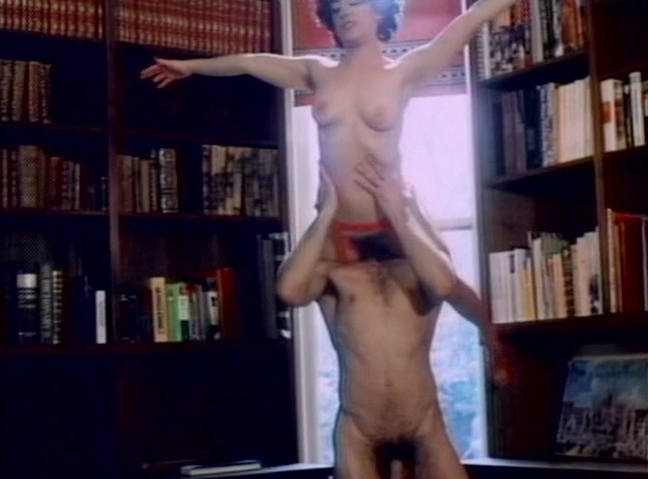 The Lewis Brothers’ ‘The Blonde’ (1980)
The Lewis Brothers’ ‘The Blonde’ (1980)
We’d save lots of money by being able to shoot two films simultaneously. For example, we found out there was a warehouse in Oakland that this guy owned which he used for all kinds of events. We walked around and looked at the different rooms, and the alley way, and where the garage was, and made some notes. Then we came up with two different storyline concepts based on the space. It wouldn’t be uncommon for one of them to be loosely based on a detective story, while the other one was something completely different – but they would both take place in the same location.
In order to make it all work, we knew we had to have a very clear plan. We went to Elliot’s house and got out paper, pencil, and scissors, and we cut out little paper dolls which represented the different characters of the two movies.
Let’s say we had one film that was a detective movie and the other was a western. We’d have these characters, and we’d say, “Okay, this doll here is the protagonist in the detective movie. And he’s also the villain in the cowboy movie. Then we have this girl. She’s going to be a criminal in the first movie and the love interest in the second.”
Then we started laying it out so that we could figure out how one guy, who was going to be the detective in the first film, could also be the bad guy in the cowboy movie. We worked out how we could shoot all of his scenes in one day. It involved a lot of costume changes, but we’d try to work it out so that we could make the most efficient use of the talent and the place in which we were shooting. The aim was to make both movies in just three days.
It worked perfectly, and after that Malibu Chicken and Stu wanted to fund more Lewis Brothers films.
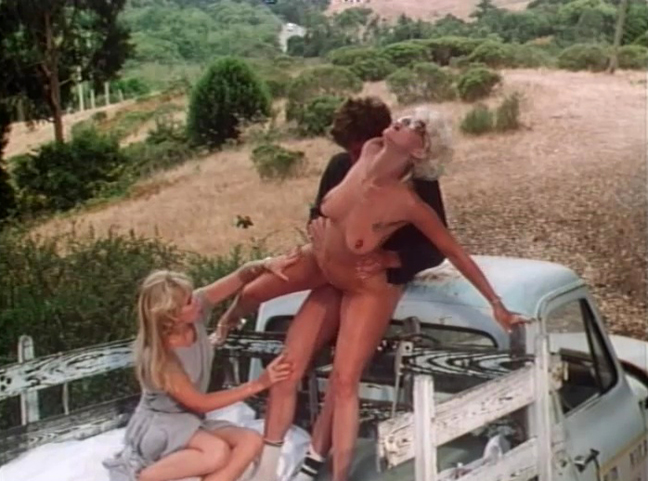 Seka and Paul Thomas in the Lewis Brothers’ ‘On White Satin’ (1980)
Seka and Paul Thomas in the Lewis Brothers’ ‘On White Satin’ (1980)
*
7. The Lewis Brothers factory
We were very well organized in other ways too. When we turned over the footage to Stu for the Lewis Brothers films, it was all completely in order. It had to be. For example, the first scene would have this detective coming down the stairs with a guy talking to him about the case; that would be scene 101A. After we finished that, the camera wouldn’t move but the actor would change his clothes. Now he was the cowboy in the next film, and he’d come down the stairs doing something else, and that would be scene 201A.
When Stu got the footage, he just separated the footage into two different bins. By the time he got it all cut up and synced, he had the two movies separated. If we didn’t have it organized that way, he’d never have been able to figure it out.
This made it as easy as possible for Stu to edit. We’d give him the script, as well as the storyboards. We’d also give him all the camera and sound reports so he could make sense out of it when he tried to sync everything up, and then he took it from there.
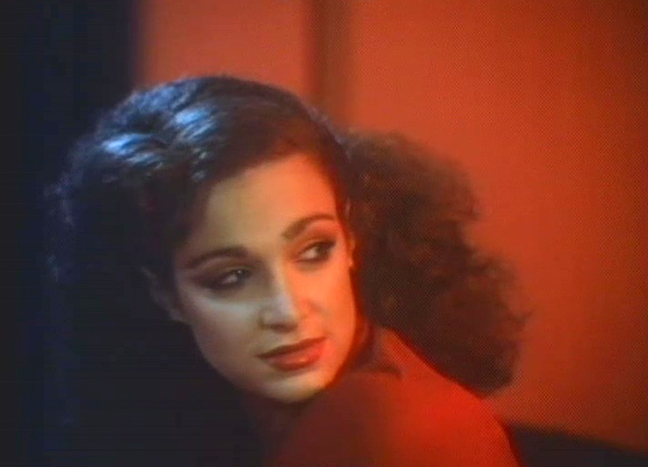 Sue Nero in the Lewis Brothers’ ‘Eleven’ (1980)
Sue Nero in the Lewis Brothers’ ‘Eleven’ (1980)
What made it even more interesting for me was a challenge that I set myself: We would never ever work more than 12 hours a day. That was my golden rule. This was important because we always used the same crew, and when people heard we were going to make a movie they actually wanted to work on our production. They wanted to be part of it because we strove to get it all done in 12 hours. We didn’t pay much but we had fun.
In those days, some of the guys like Sam Weston would shoot for 22 hours straight. It was ridiculous how long they would go. I just said, “Hey I want to make money and I want to learn. But I want this to be fun. I want people to want to work for us. I want them to say, “Lee and Elliot are making a movie. I want to be on it because I know I’m going to go home at a decent hour.”
So every time we made a film, we’d do it the same way – with these paper dolls to create two storylines. We soon turned over the two stories to a friend who would write the scripts with all the dialogue. Elliott’s wife was onboard too, and she handled the wardrobe and the production design. It was a cottage industry. It was a wonderful little machine.
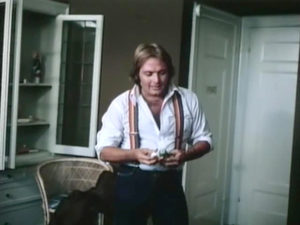 We did the casting ourselves. Elliot and I used this Texan guy who lived in Sausalito named Milton Ingley. He knew where everyone lived so he’d schedule a cattle call for us at his house, and we’d hold interviews to see if people wanted to be in the movie. Milton was also an actor who went by the name Michael Morrison, but we just called him ‘Big Milton’. We’d take Polaroids there and figure out which paper doll each person was going to be in the film. Sometimes we had casting input from Malibu Chicken. He may ask us to get someone like Lisa De Leeuw or Dorothy LeMay for example based on who was the hottest girl was at the time.
We did the casting ourselves. Elliot and I used this Texan guy who lived in Sausalito named Milton Ingley. He knew where everyone lived so he’d schedule a cattle call for us at his house, and we’d hold interviews to see if people wanted to be in the movie. Milton was also an actor who went by the name Michael Morrison, but we just called him ‘Big Milton’. We’d take Polaroids there and figure out which paper doll each person was going to be in the film. Sometimes we had casting input from Malibu Chicken. He may ask us to get someone like Lisa De Leeuw or Dorothy LeMay for example based on who was the hottest girl was at the time.
We probably repeated this process four times a year. We made something like 15 of these films in total. We did it again and again using the same formula.
The Lewis Brothers films all looked a lot better than the ones that I had done for Jerry that were all blow ups from 16mm. We shot in all kinds of different places, such as at a house near Stinson Beach where a famous beat poet used to live. Elliot had worked on so many big budget X-rated films that it wasn’t difficult for him to find these places. The people that owned them knew him from previous productions so the door was already open for him.
We also used the same crew too: There was Michael Lewin who was my camera assistant on many of the films. There was a grip named Sleaze, who looked like he was in ZZ Top. Big beard. There was a guy named Curly Eason who often did the lighting. He and Elliot were real tight. Then there was Charlie Stephens. He was on our crew for all of them. We also had Jerry and Marion Cronin. They were a husband and wife. Jerry helped with the lighting. Marion did continuity. And of course, Vincent Fronczek. He was the film photographer.
Elliott came up with our collective name, ‘The Lewis Brothers of Detroit’. He said we needed to have different names because at the time what we were doing was against the law. People were being busted all the time for making adult films. He wanted to make sure that if the cops were looking for us, they would start out in Detroit and not in San Francisco. So, in the film credits, I took the name Harry Lewis, Elliott became Elliott Lewis, and Elliott’s wife was JoAnn Lewis.
A number of the films were credited as being made by ‘Artimi Films‘. That was just the name Malibu Chicken gave to our informal production group.
We never had many problems on our sets. Things went smoothly. When I worked on other people’s films I remember it was always a problem to start on time, or there were technical issues where they blew the power off of a telephone pole outside and everybody had to hide, that sort of thing. But on our films we never had major problems. We hired people that were experienced so it was straightforward.
Not to say we didn’t have the occasional mishap. For example, some people took longer to do their work than we could afford. Curly would light everything; he was one of those guys that if I would’ve let him, he would’ve kept fine-tuning things and putting up flags and scrims on the lights forever. He never would’ve come to me and said, “Lee, we’re ready to shoot.” Never.
So instead of getting upset with him, I would just get to the point where I’d say, “Okay. Roll sound and roll camera”, and Curly would still be on the ladder trying to get out of the shot during the first take. That was the only way he knew he had to move or he was always going to be in the background of the movie.
I wanted the films to be as good as they could be – but the real success of the whole project was whether you were on budget. That to me was more important than anything else. Elliot loved this approach because we never had to pay overtime, and so it made his job easier. And as we didn’t have any money to pay overtime, that was a relief to everyone…
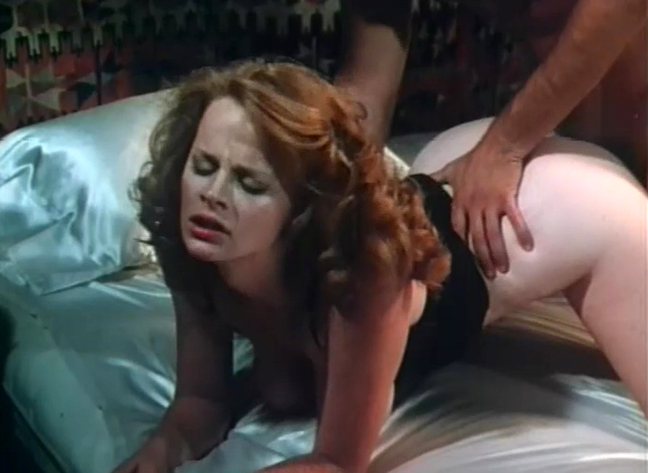 Lisa DeLeeuw, in the Lewis Brothers’ ‘On White Satin’ (1980)
Lisa DeLeeuw, in the Lewis Brothers’ ‘On White Satin’ (1980)
The years that I spent working with Elliot in the X-rated film industry created one of the most enjoyable relationships and friendships that I had. We were tight, and we worked well together. We were always laughing and having fun.
I remember Harry Mohney was once on set with us. We were being disturbed by the noise of the next door neighbor who had decided that he’d mow his lawn just as we were starting to shoot. Harry peeled off a few banknotes and persuaded the guy to postpone his yard work. Obviously the neighbor got wise to this, and half an hour later returned with a chainsaw and started trimming his trees – making even more noise. Harry had to go over and pay him off a second time… and this time, made it clear he didn’t want any more noise.
The strange thing is that I never went to the movie theaters to see any of the films – and I never got any of them on video when they came out, even just to see how they turned out.
I was aware of the stigma attached to being involved in this industry. I remember trying to go out with this girl once. She was working in legitimate films as a script supervisor. She knew that I was making X-rated movies. I took her to a party at Elliot’s house, and I got separated from her. When I came downstairs I found her talking to a gaffer that had also worked on X-rated films. I was standing behind him and I could hear him saying that she shouldn’t be dating me because I was a sleazy guy who worked on porno movies.
My parents wouldn’t have understood either. My father was a dentist. I remember being at my dad’s dentist office getting my teeth cleaned once and I looked out the window and across the street at the Corbin Theater, they were playing ‘Oriental Treatment’! I couldn’t tell my dad that. And if my mother found out she would die. She’d be so embarrassed. I remember after my trial my mother said, “All I wanted you to do was be a milkman. Just something that I can be proud of.”
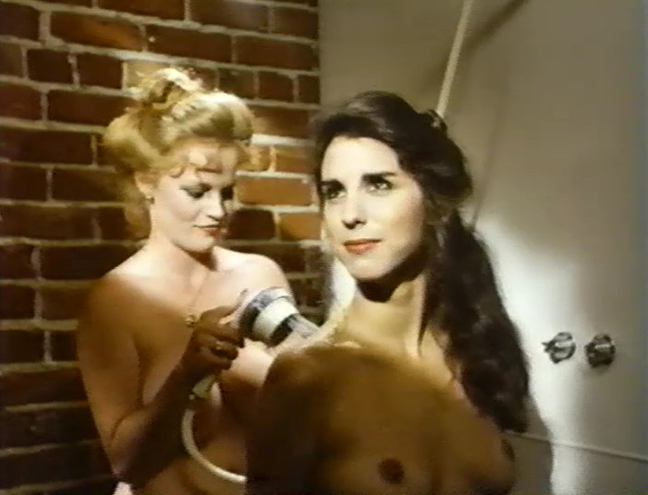 Lisa DeLeeuw and Nicole Black in the Lewis Brother’s ‘Ladies Night’ (1980)
Lisa DeLeeuw and Nicole Black in the Lewis Brother’s ‘Ladies Night’ (1980)
I think my last film with Elliot was at the ABC Can company. It was a gigantic warehouse on 3rd St, and Bob Vosse had the lease on this place. They shot a lot of features there. I had a 67 Alfa Romeo Duetto Spider. Red sports car convertible. We brought it up into this warehouse in the freight elevator. Somehow it fit in the elevator, and we worked it into the movie.
It was a sad thing for me when it all came to an end. This is what happened: We were scheduled to do yet another two films. I also had an offer to shoot something for Bob Vosse, who made the Swedish Erotica loops. I wanted to do it because I wanted to work with Bob. And then out of the blue, I was asked to go to North Dakota with Lucas Films to shoot background plates for ‘Indiana Jones and the Temple of Doom’ (1984).
All of the work I’d been doing all those years was building up to be able to do that kind of work.
I told Elliot, “I have to do this. This is what it has all been about. I enjoy doing this with you. I love you, but this is the pay-off. I can finally work on a film that I can tell people about. I get to work with Michael Owens, who’s an amazing DP.” (Michael had a recent credit on the film ‘Sully’).
I said, “I hope you can understand.” He was very upset.
I recommended that Elliot get Kenny Gibb to stand in for me on the next Lewis Brothers movie – which he did. They shot it at Bob Vosse’s studio in San Francisco. Elliott and Kenny did all the pre-production, including cutting out all the paper dolls as usual. I fully expected to come back and continue working with Elliott, but after that, Elliot never invited me back. The Lewis Brothers continued without me. I don’t even know how many more films they made after I left.
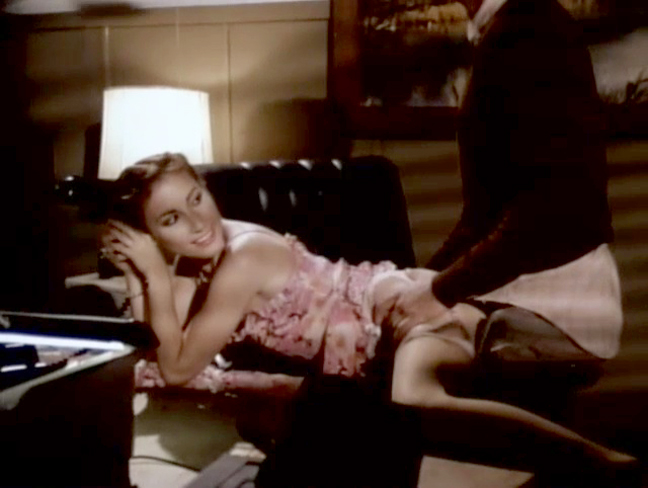 Loni Sanders as ‘R69D69’ (!) in the Lewis Brother’s ‘Trashi’ (1981)
Loni Sanders as ‘R69D69’ (!) in the Lewis Brother’s ‘Trashi’ (1981)
*
8. Rental Business
As a result of my work outside of the Lewis Brothers, I was able to join the cameraman’s union 659 and work on many television commercial and feature length films.
I was getting hired more and more – not just as a camera assistant or cameraman – but for the camera equipment I had. I could offer it to crews for less money than if they went to a real rental house. I had no overhead. I knew what they were doing, and they knew that they weren’t going to have a problem with me.
In the 1980s I’d rent my camera equipment to people like Dan Cady and I’d also work as the camera assistant. He’d bring in cameramen to shoot the film. When the cameramen went on to do legitimate films, sometimes they would have to bring the equipment with them. And that was how I branched out into that side of the business. After a while I stopped working on film sets and focused on the mainstream film rental business. My business became ‘Lee Utterbach Camera Rentals’.
I opened a camera rental house in San Francisco. I devoted all my time to renting motion picture camera equipment and supporting the needs of the San Francisco film community. I worked with many of the biggest names in the mainstream movie business. That aspect of my career lasted for over 25 years. I gradually lost touch with most of the people from my past life in the adult film world.
I would just see a few of the people from the old days – and one of these was Dick Miller / Mr. Mustard. He’d left New York and moved to California, and he would cast his films out of a place in Hollywood on Sunset Boulevard that was also an agency for bands.
Eventually Dick came down with some disease. It was something that affected his skin. He’d get these shots that would help it, but eventually his insurance ran out and he couldn’t afford the shots anymore. He got depressed about it. Like I said, his looks were important to him. He was staying Rudy’s place, and one day he put a lounge chair out on the deck and hung a furniture pad behind him and took a gun and shot himself in the head. It was a very sad way to go.
Recently I reconnected with Elliott – after years of not talking. He’s gone on to be a very successful production manager in Los Angeles. We’ve started to speak more regularly recently. I didn’t know how I would feel about it but it’s been good to remember the old days.
My rental business ended up being the last 35mm camera rental house in the San Francisco Bay area. It lasted over 30 years until November 2010 when I closed the doors, sold the building and all the camera equipment, and retired.
My wife and I moved to Arizona in December 2016. I’m now restoring an airplane that my father built and left to me.
Looking back, I feel like I’ve had an interesting life and met and worked with a lot of interesting people. During my stint as an assistant cameraman, I worked with Diane Keaton, Albert Finney, Stewart Granger, Melvin Douglas and many other Hollywood actors, talented directors like Bob Girardi, and cameramen like Michael Chapman and Michael Owens.
However, some of the most fun times I had was the time I spent as Harry Lewis with Elliot Lewis making the Lewis Brothers films.
*
Update (February 8th, 2017):
An interview / article about Lee Utterbach’s rental business, can be viewed here.
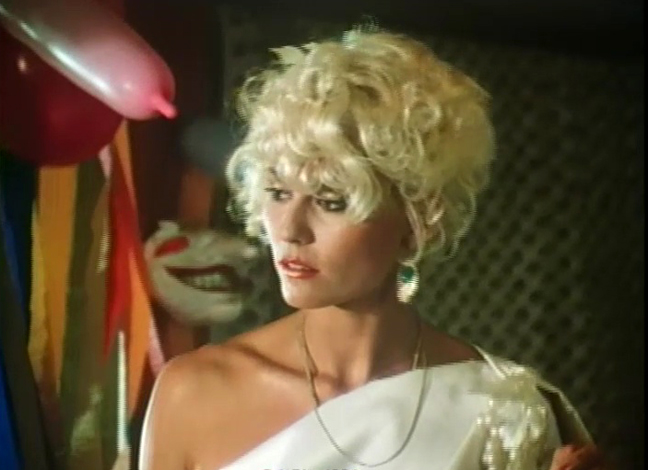
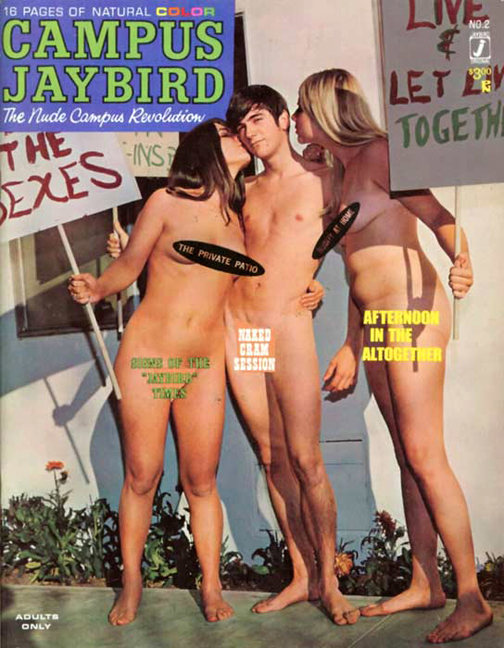
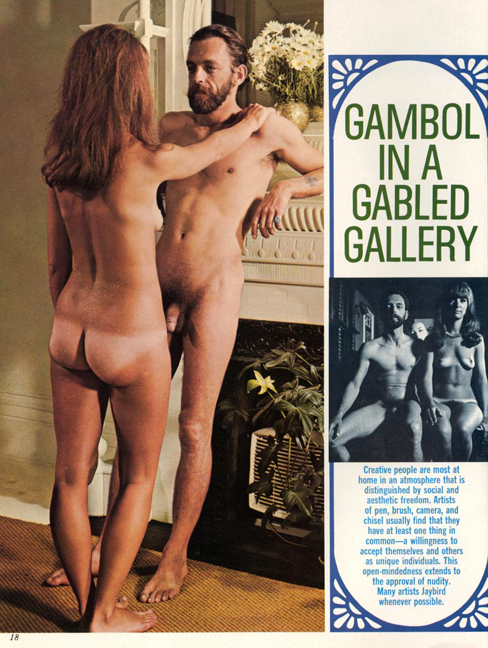
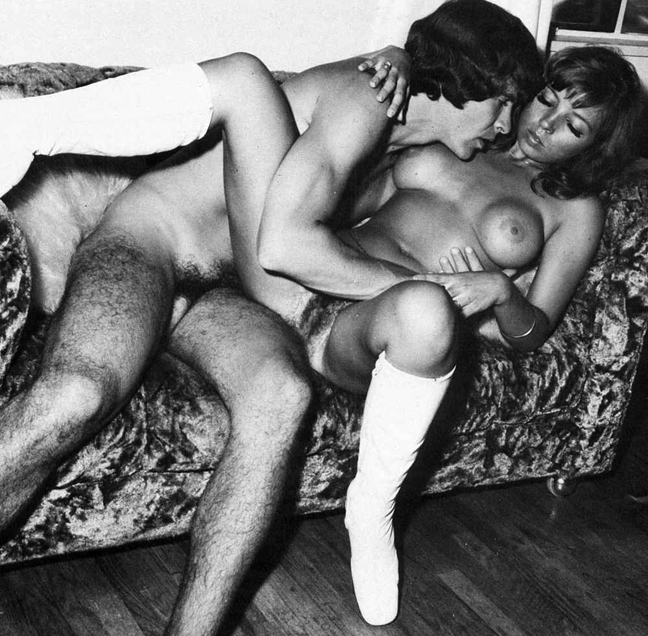
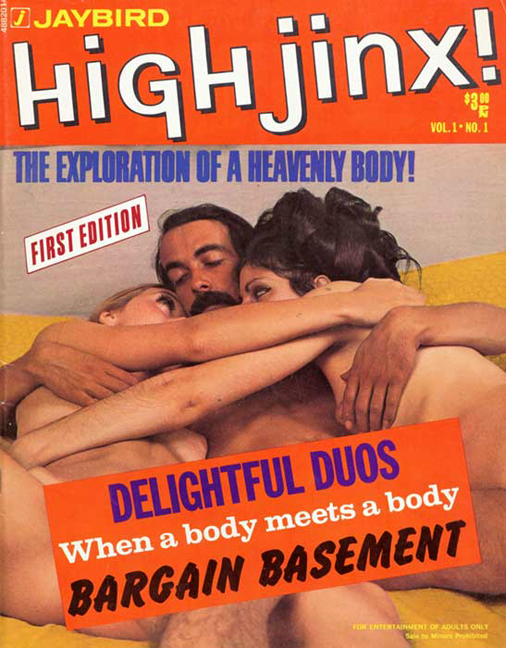
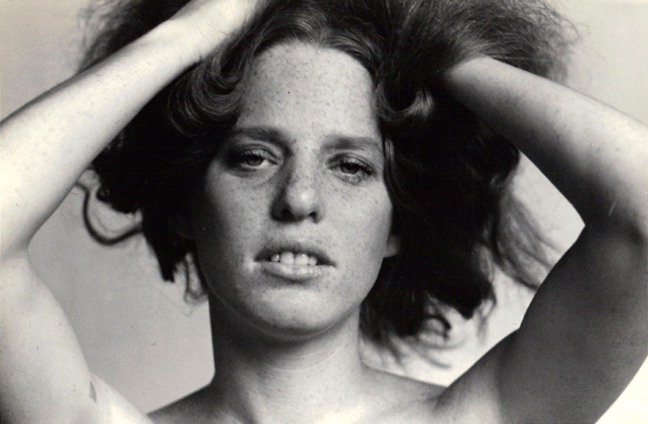
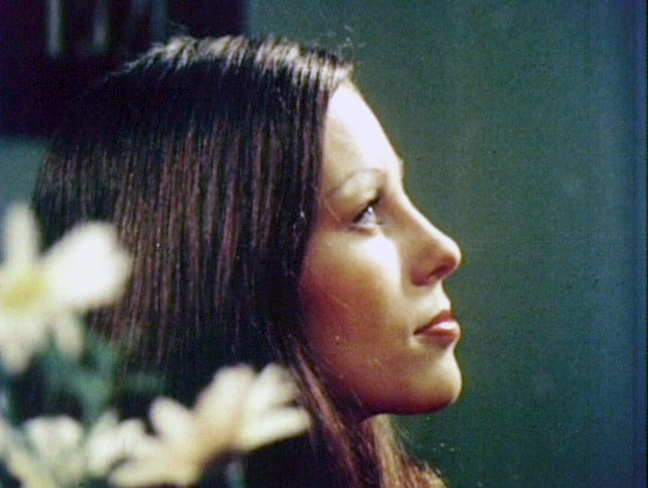
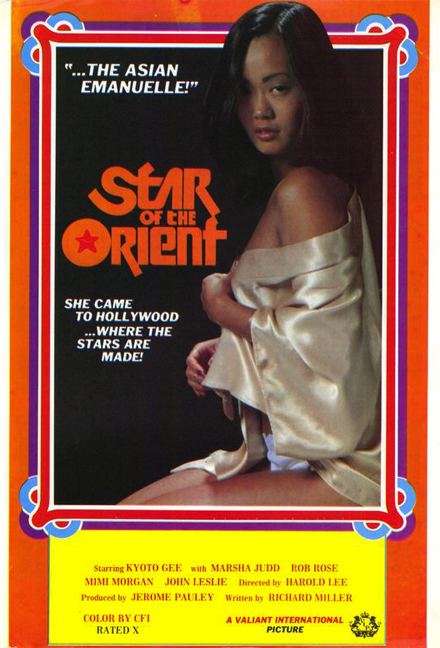
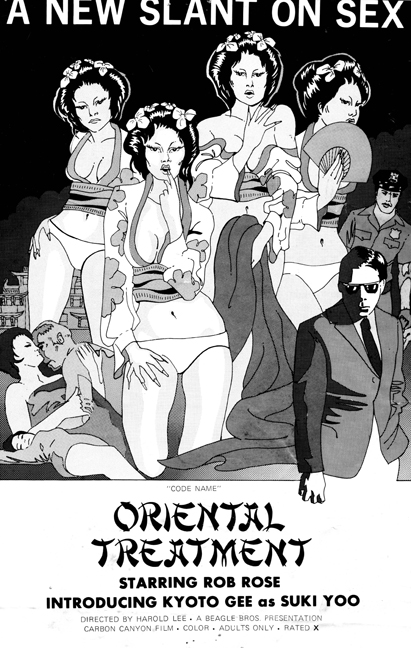
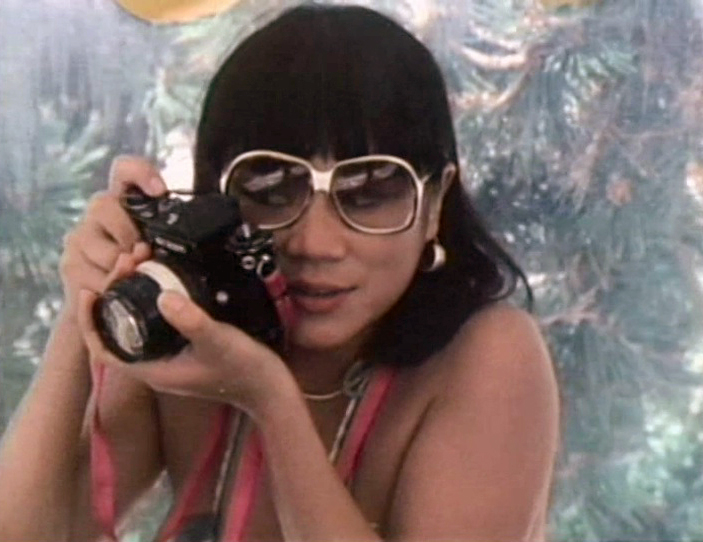
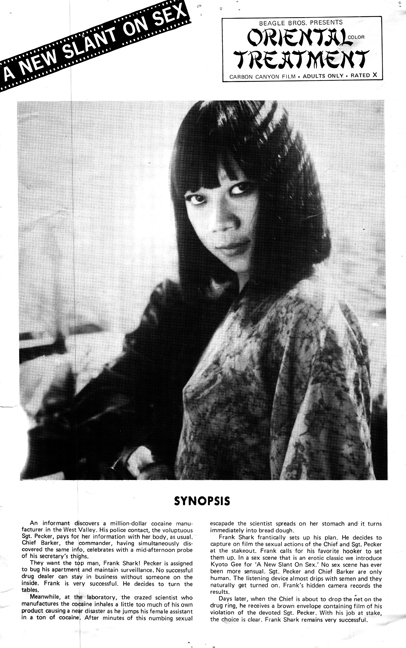
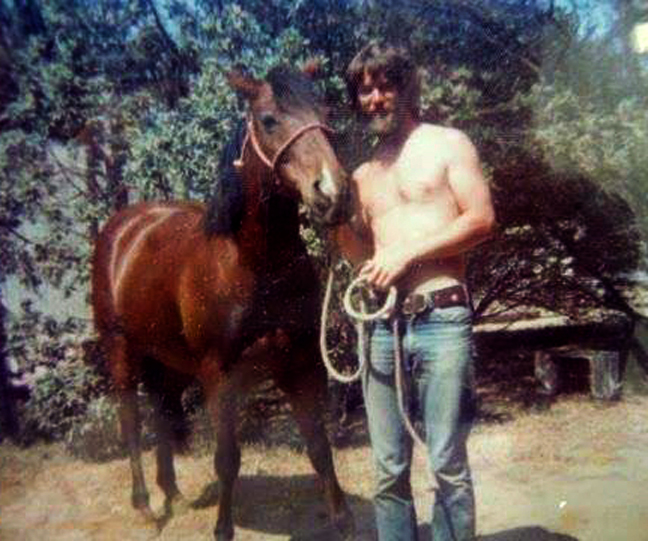
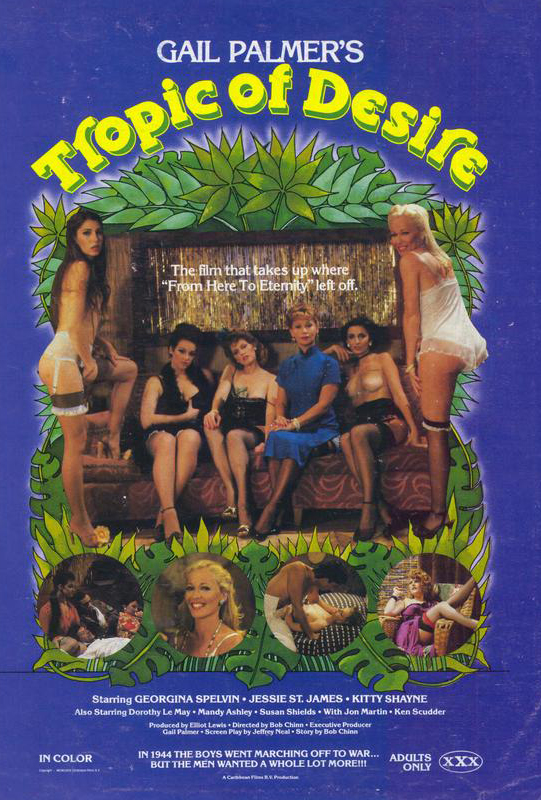
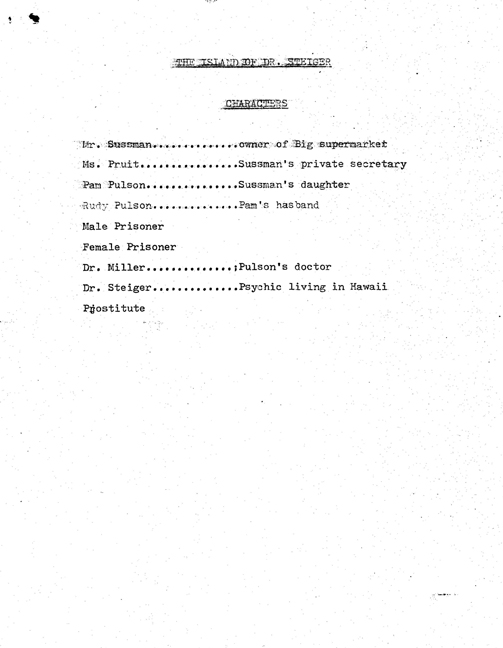
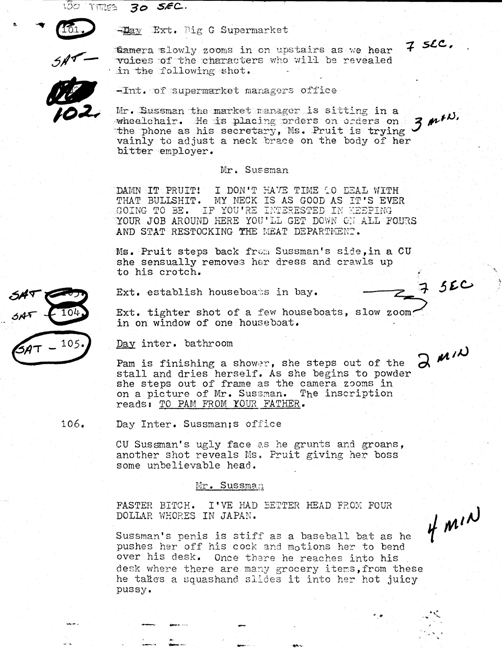
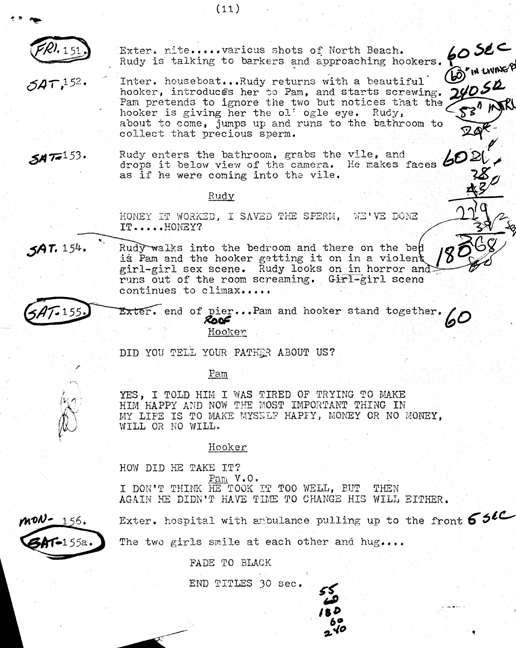
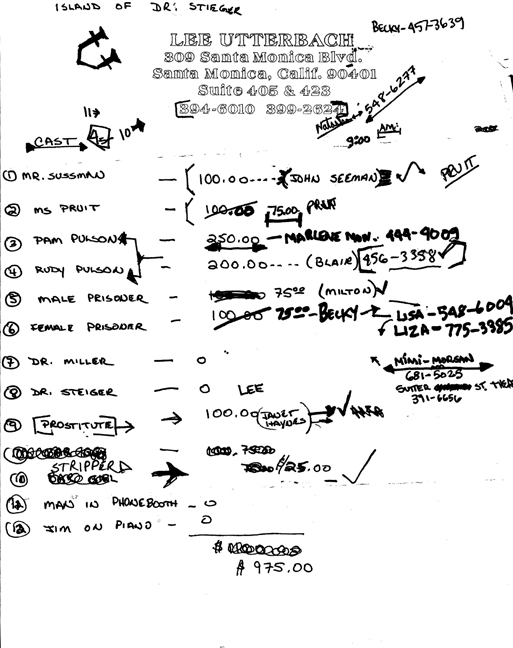
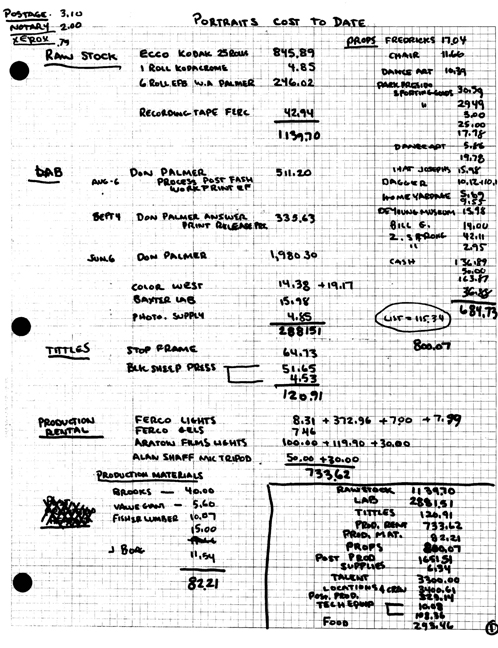
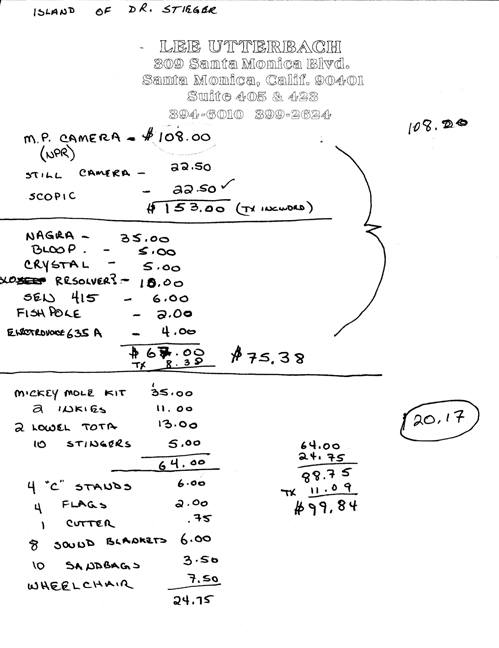
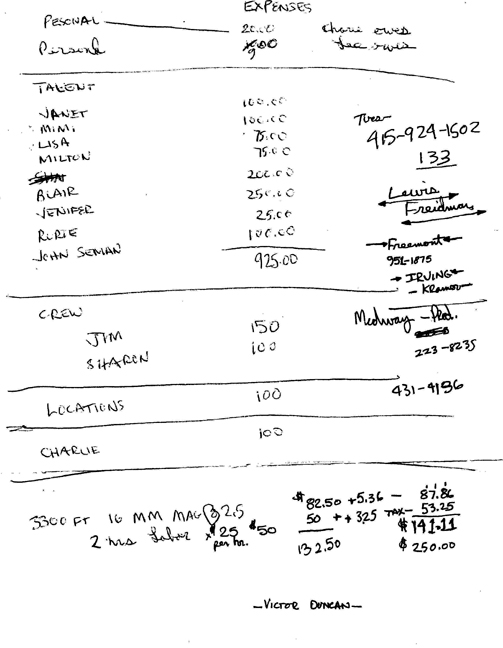
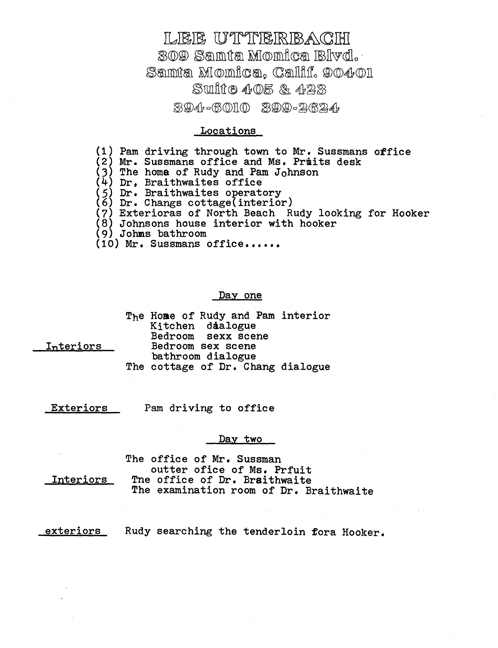
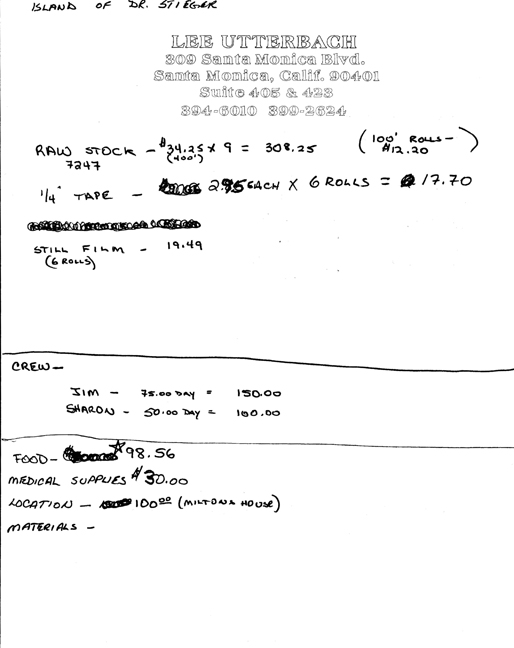
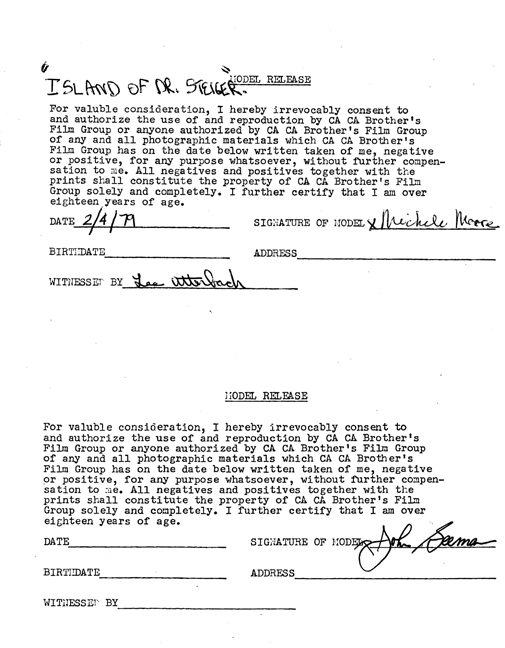
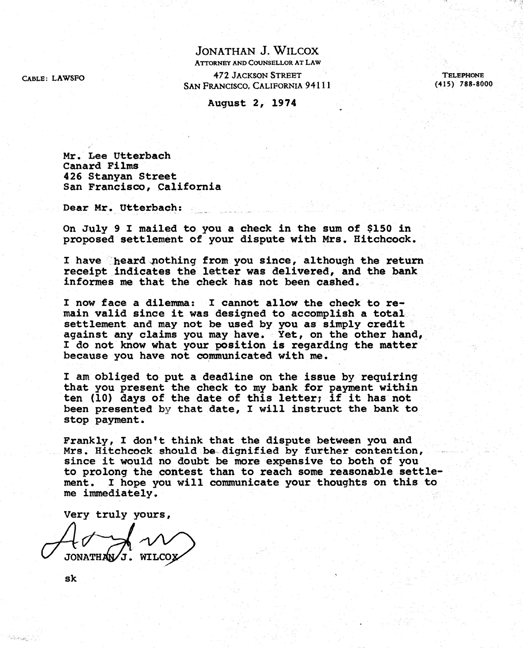
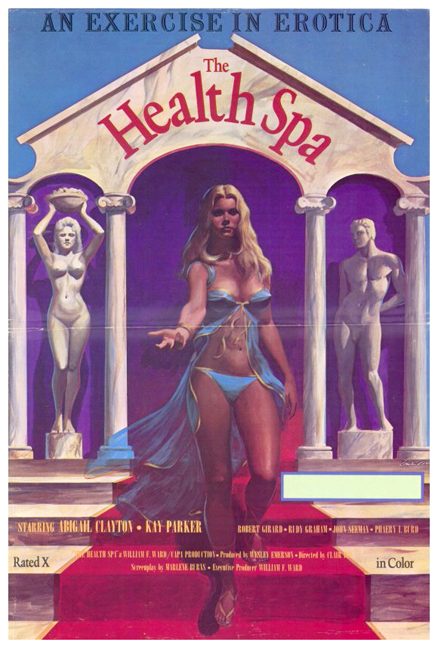
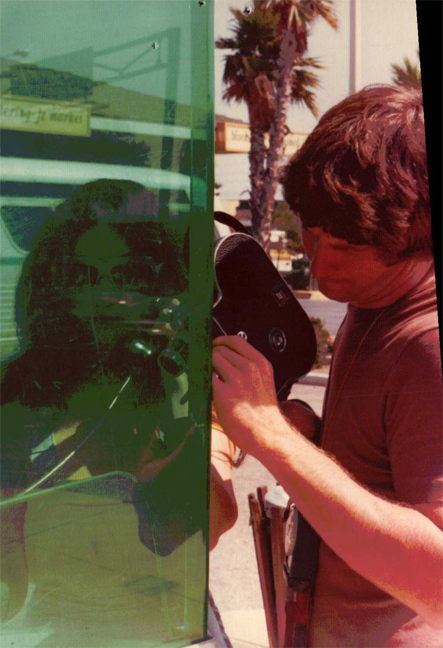
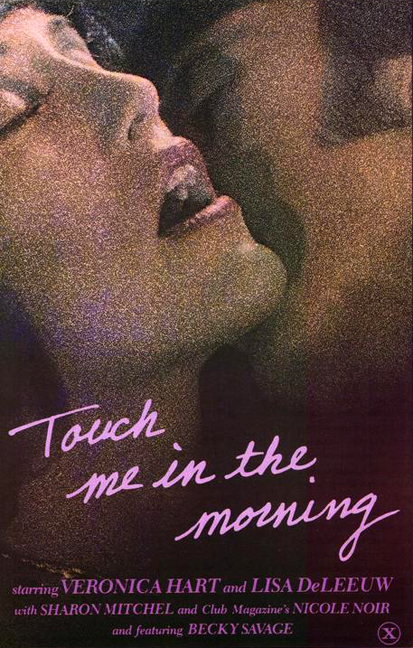
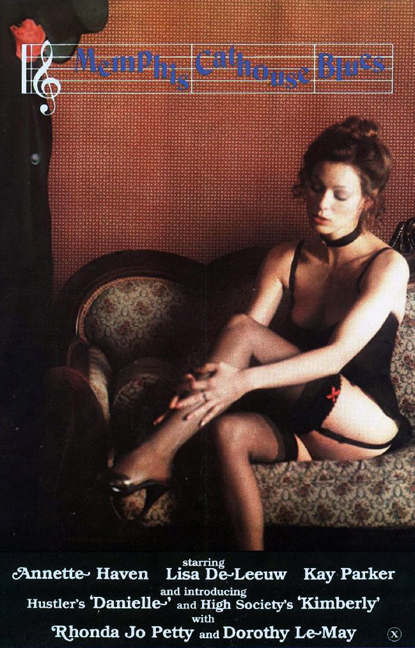
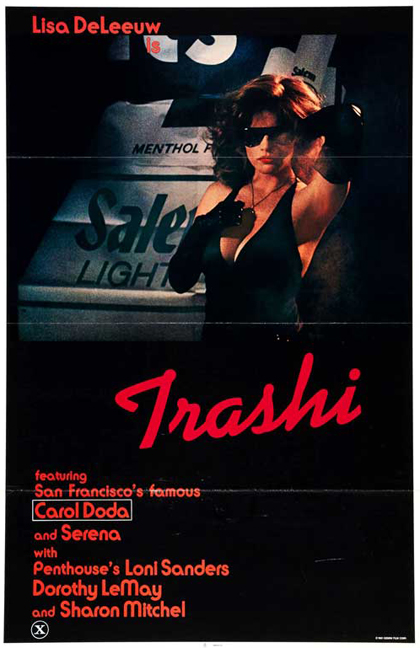
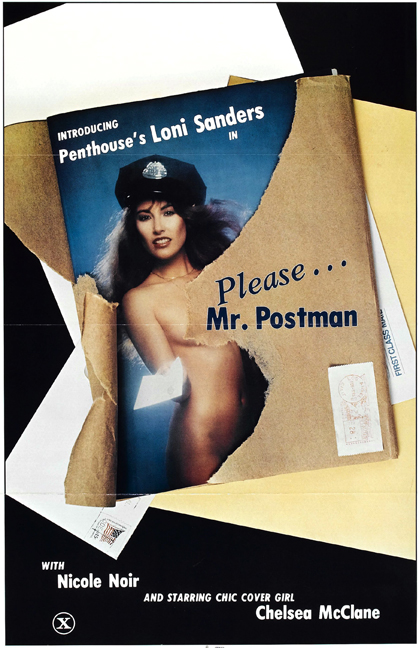
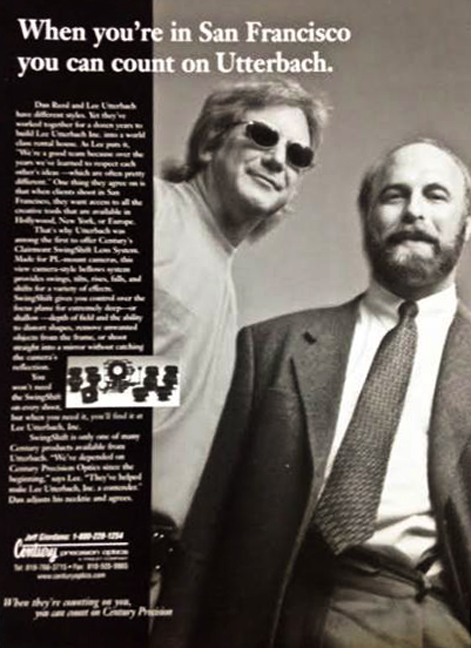
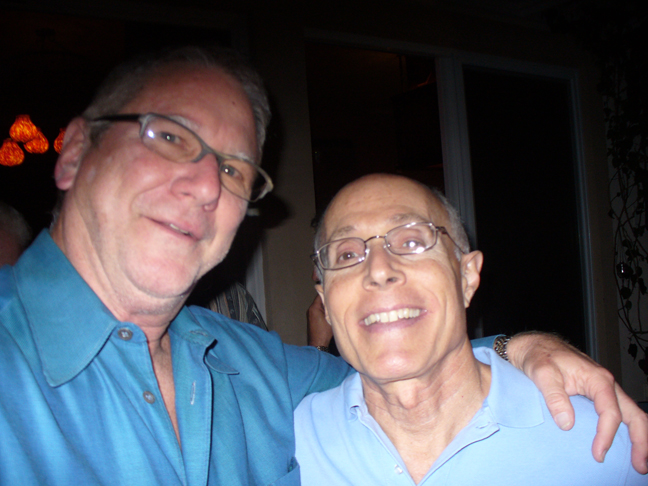
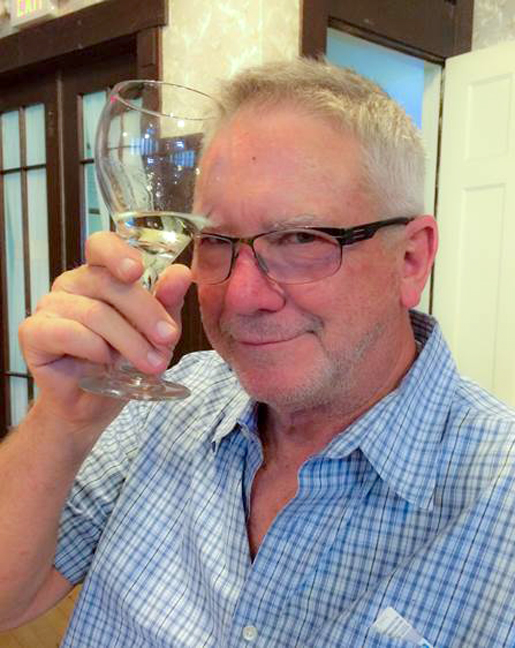

As the good folk at the Rialto know, I have been hounding them for years to provide more details about the mysterious Lewis family… I have looked everywhere for information but everyone was just keeping quiet.
Phenomenal read. And amazing to hear the pre-story and post-story too. What an interesting life.
Thnaks to Mr. Utterbach for this life story. It is fascinating and lives up to expectations.
Great read, and I was fascinated to hear the identity of Stanley Kurlan, the one-off director of ERUPTION.
big fan of the various ‘Lewis’ -made films so naturally i ate this one up. the way that the film-making process was industrialized (using cut-out figures etc.) is hilarious, as is the story of harry mohney. thank-you.
Is there any way of finding what the various ‘pairs’ of movies were – given that they were made 2 at a time?
I’d like to do a scene-by-scene comparison of them.
My opinion is that TOUCH ME IN THE MORNING was the best Lewis film followed by MEMPHIS CAT HOUSE BLUES and PLEASE MR POSTMAN and SMALL TOWN GIRLS.
Very informative story.
Very enjoyable read.
(Is that doctor with the glucose trick still around!?!)
1 roll Kodachrome 4.95
Yup, I miss film too…..
Wow, again. Your subjects continue to fascinate!
Excellent story… which (for ocne?) ends well!
PS : Nicole Black… please find her! 😉
Awesome blog. Thanks Harry / Young Lee / Lee / Beagle Brother / Mr Kezar!
The production notes are staggering. The prices are… low!
How times change.
This story was a lot of fun to read… Kinda-sorta like the WONDER YEARS. But, with sex… ha-ha. Anyway, it brought back some good memories of California.
The part about Ric Lutze and the socks, was really funny.
So, it’s NOT ok for a teacher to appear in a ‘dirty’ magazine, but it IS OK for the administrators to read them AND take them to school?!…. Some things never change.
Out of curiosity, does anyone know how many issues of CAMPUS JAYBIRD were printed? Also, the years they were printed in?… The book ‘NAKED AS A JAYBIRD’ is out-of-print, and I can not afford to pay a couple hundred bucks just to find out the answer.
I think you need to talk to Sue Nero!
Yes – I agree. Sue must be interviewed here. Please………………!!!
Seconded!
GREAT STORY! LEE AND YOU RIALTOS, YINS ALL DID YOURSELF PROUD!!!!!
– the ghost of RICHARD PACHECO
What about “Louie Lewis”?
I’m assuming “Louis Lewis” was Ken Gibb. Also, in the second post (from Kerrville Ken) where is Stanley Kurlan identified?
Thanks to all involved with creating the Report and those who have shared their memories- it’s always a fascinating read. Especially found the documents relating to “Island of Dr Steiger/Love” interesting- they reinforce the idea these movies were hand-crafted in a more personal way most modern movies- mainstream or otherwise- don’t seem to be.
And since comments here are an opportunity to make requests- Mimi Morgan! She looked like someone who might be working in a bank or maybe teaching school when not onscreen- where she was someone less… sedate, shall we say.
Loved reading about your whole story, Lee. I miss you and the good old days when we were on a film set together. I have many beautiful memories of working with you and knowing you. I consider you a dear friend and always will. Hope we meet again before too long.
John, is King Paul still alive? it seems he dropped off the radar in 1984?
Wow, RR, that really hit the sweet spot. Near as good as a time machine.
I know that ’67 Spider well, as it’s the centerpiece of a loop (‘Commercial’) with Christy Canyon.
BTW, surely that’s goddess Loni Sanders, not Dorothy LeMay, in the ‘Trashi’ still?
I wondered if anyone else noticed that. That aside, this was another fabulous Rialto Report effort…this was a “page-turner!”
Fixed! Don’t know how that slipped through the net…. Thanks.
I was completely enjoying the article until the crack about the ugly people in the Mr. Mustard films. Since I was one of the people who worked a lot for Dick it bothered me until I remembered how much fun we had on a Mr. Mustard production. I did so many scenes with Marlene Willoughby at one point we felt married. But it was fun to get a look at the West Coast business which was like a different world to us East Coast types
Interesting info on one of the court cases:
http://law.justia.com/cases/california/court-of-appeal/3d/56/321.html
Best sentence in the opinion:
It seems self-evident that if A pays B to engage in sexual intercourse with C, then B is engaging in prostitution and that situation is not changed by the fact that A may stand by to observe the act or photograph it.
This was a really good interesting read, without a bittersweet ending. Excellent as usual. Thanks RR.
I have a 16mm print of “House of Green Desire”, directed by Charlie De Caca. Nice to finally know the connection.
Lewis Brothers movies were great films!!! That is all.